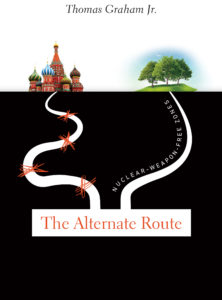 Ambassador Thomas Graham, a member of the Center’s National Advisory Board, recently published a book, The Alternate Route: Nuclear-Weapons-Free Zones.
Ambassador Thomas Graham, a member of the Center’s National Advisory Board, recently published a book, The Alternate Route: Nuclear-Weapons-Free Zones.
I asked him a few questions about the book and his thoughts on the current state of global nuclear disarmament. This interview has been edited for clarity and brevity. This interview will be posted in two parts.
Why did you write this book?
One of the reasons I wrote this book is because nuclear-weapons-free zones are important to the cause of nuclear disarmament, and have been paid very little attention, at least in this country. To the best of my knowledge, this is the only book that has ever been written exclusively about these agreements — I’ve seen chapters in other books, but never a whole book.
What is a nuclear-weapons-free zone?
A nuclear-weapons-free zone is an agreement of countries in a particular region prohibiting nuclear weapons, and any research or development related to nuclear weapons, anywhere in the area covered by the treaty or, in other words, the zone of application of the treaty.
Let’s take Latin America for example: all 33 countries are parties to its Nuclear-Weapon-Free Zone Treaty for that region. It has verification provisions, and all countries in the region have agreed to support it. There is an implementing body for the Treaty. And there are two protocols to the treaty: one protocol provides for those states that are not in Latin America but have territories in Latin America, like the United States, to put their territories under the provisions of the zone. That means there can never be a nuclear weapon in Puerto Rico or in the Virgin Islands. In the second protocol, the five NPT-recognized nuclear-weapons states, often referred to as the P-5, agree they will not use or threaten to use nuclear weapons against parties to the treaty.
So, Latin America is totally nuclear-free, with one exception: nuclear weapons states may send vehicles through the zones that contain nuclear weapons — airplanes, ships, submarines. That was a condition of U.S. support. Other than that, nuclear weapons cannot be placed anywhere in the zone.
Why aren’t there more of these zones?
The majority of the countries of the world are party to a nuclear-free zone treaty; I believe approximately 52% of the land area and 111 countries are included in various regional free-zone treaties. Areas not covered by such a zonal treaty are North America, NATO, Russia, China, and the three most difficult areas: the Middle East, Northeast Asia and South Asia.
It would take a special effort to expand the area covered by nuclear-free-zone treaties much further. South Asia would be really difficult. I think the Middle East would be possible before South Asia. It’s imaginable — not likely, but imaginable — that there could be such a zonal treaty in the Middle East and Northeast Asia as well.
So, in reference to the book title, what is the alternate route, and where does it lead?
Well, it’s difficult — though not impossible — to work with Russia today because our relations with them have worsened. Beyond extending the New START agreement, it is difficult to imagine further progress in the near-term. We always used to do new nuclear weapons agreements first with Russia, but if that’s not realistic, do we just give up? Or do we search for an alternative?
The alternate route would be to try over many years to expand the nuclear-weapons-free zone concept to new areas, which wouldn’t require negotiating with Russia. The parties of the regions would do the negotiating amongst themselves; they’d work out nuclear disarmament for themselves. Then they’d complete the protocol and ask the P-5 to sign — that’s a yes or no answer, and like us, Russia can decide for themselves whether they’d sign. They probably would.
